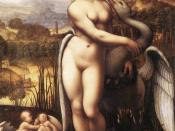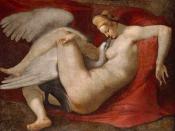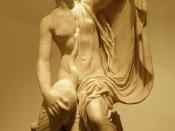W.B.Yeats and Leda and the Swan Given the odd tales brought to us by Greek mythology, one could very well imagine the stories having been unearthed from some antique tabloid magazine. In the case of Leda, subject of W. B. Yeats' poem "Leda and the Swan," the banner headline may have run as follows: "WOMAN IMPREGNATED BY SWAN, FOUR CHILDREN HATCH FROM EGGS". Kind of brings new meaning to the phrase "love nest," doesn't it? All joking aside, the myth of Leda and the swan features Zeus (most powerful among the Greek gods) coming down to earth in the form of a swan to woo Leda, wife of Tyndareus. She winds up giving birth to four children, two mortal (Castor and Clytemnestra) and two immortal (Polydeuces and Helen). Yeats' poem focuses not on the monumental events that Leda's offspring went on to experience (and cause), but rather on the moment of the meeting of woman and winged one.
As for the classical mythological history of Leda and Zeus, Carlos Parada's Genealogical Guide to Greek Mythology tells us that Zeus, in swan form, joined with Leda, on the same night that her husband had. Zeus's children, Polydeuces and Helen, were born from an egg laid by Leda and Tyndareus' children were Castor and Clytemnestra. However, some say that Helen was a daughter of Nemesis and Zeus and brought (in egg form) to Leda by a shepherd. When the egg hatched, Leda brought her up. Legends also say that Leda died of shame for her daughter Helen. As an aside, Castor and Polydeuces were also known as Castor and Pollux, the twins of Gemini.
The first quatrain of Yeats' work describes the initial encounter between woman and bird. The swan, normally a symbol of beauty, is here depicted as brutish,


